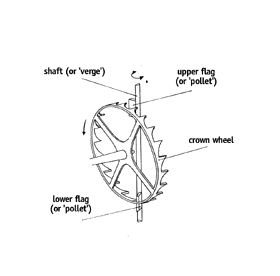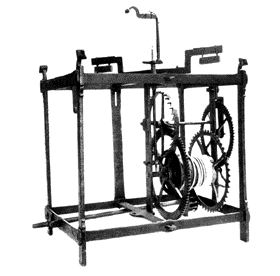

The first mechanical clock to be made does not survive. Indeed,
neither the inventor, nor the place nor the date of the first
mechanical clock is known, but by about AD 1300 most European
countries, England, France, Italy and Germany, had some form of
mechanical clock in regular use – that is to say, a weight-driven
timepiece with a bell.
Until the Gothic Middle Ages, man had measured time by such devices
as "shadow-clocks" or sun-dials, water-clocks or "clepsydrae".
The Babylonian and ancient Egyptian civilizations, followed by
the Greek and Roman cultures, depended on these non-mechanical
means for measuring time. From the beginning of the Christian
Era until long after the invention of the mechanical clock towards
the end of the thirteenth century, the scribes use the same Latin
word, horologium, to denote any instrument concerned with the
recording of time, be it a sundial, a water-clock, or a mechanical
weight-driven clock, and consequently the early entries so far
traced in the surviving records are frequently ambiguous. In themselves,
these entries rarely provide evidence of the exact date of a change
over to a weight-driven mechanical clock. However, the absence
of any reference to mechanical clocks in two important thirteenth-century
works – the Computus maior written by Campanus for Pope Urban
IV between about 1261 and 1264 and the Liber del Saber Atronomico
produced for Alfonso X of Castille in 1277 – has led historians
to the tentative conclusion that the mechanical clock was probably
not invented before 1280. As the number of significant records
which may plausibly be interpreted as to referring to mechanical
clocks increases rapidly during the next fifty years, it would
seem that few of the great monasteries, abbey churches and cathedrals
in Europe had not set about installing some kind of mechanical
clock with a bell before the middle of the fourteenth century.
A document of 1302 from the rich Benedictine Abbey at Ely, for
example, make sit cleat that the monks were to assemble for prayer
at the correct times during the day and night with the assistance
of a clock, which had to be kept in good order for that purpose.
Between 1321 and 1325, another powerful Benedictine abbey in East
Anglia was paying two clockmakers, Roger of Stoke and Laurence,
to build a particularly fine clock for the Cathedral in Norwich.
It took nearly three years to complete, but it seems to have additional
dials for the sun and the moon and may also have had an alarum
mechanism.
With the Gothic invention, the timekeeping was, for the first
time, governed by a repetitive mechanical motion lasting as long
as a driving force was maintained. This driving force in those
earliest days of clockmaking was provided by weights and the brilliance
of the new invention lay in the fact that it could control and
slow down the speed in which the weights dropped. The mechanism
for slowing down and evening out the spending of this power from
the weights was called an "escapement". The earliest surviving
form of an escapement has come to be known as the "verge escapement"
and it was one of those great and fundamental inventions which
have profoundly affected the history of men.

The verge escapement remain the only form of escapement generally
used in all clocks and watches until about 1670, nearly four centuries
after its successful, but as yet anonymous, application to the
problem of time-measurement. The verge escapement consists of
three parts, which can most clearly been seen and understood in
the large "turret" clock from Cassiobury Park, which, like the
Dover Castle clock (now in the Science Museum, London), was formerly
thought to have been made in the fourteenth century. Both are
now regarded as probably no older than the sixteenth century.
Nevertheless, the method of construction of this clock, with its
massive heavy wrought-iron frame and mechanism, is in the medieval
tradition and scarcely differs from the oldest surviving clock
in Britain – the Salisbury Cathedral clock of 1386.

The three parts of which the verge consists are, firstly, the
"crown-wheel", a wheel with an uneven number of teeth standing
at an angle of 90º to the plane of the wheel; secondly, a shaft
(or "verge") on which are two rectangular projections known as
"flags" (or "pallets"); and thirdly, at the top end of the shaft
either a horizontal bar called a "foliot" or a large wheel called
a "balance". The action of the escapement is very simple: as the
weight is applied to the "going-train" of wheels meshing one into
the other, the crown-wheel is turned. The top pallet is thereby
pushed aside by a tooth on the moving crown-wheel and in consequence
the verge is turned as so is the foliot on the top of the shaft.
During this turn the tooth of the crown-wheel "escapes" from contact
with the top pallet; at the same moment, the lower pallet is caught
by a tooth on the lower part of the crown-wheel, which is of course
moving in the opposite direction to the top of the wheel. Because
there are an uneven number of teeth of the crown-wheel, when the
lower pallet is engaged by a tooth, the upper pallet will coincide
with the space between two teeth. The verge is impelled to move
in one direction by the force of the tooth of the crown-wheel
on the pallet until it escapes, at which the other pallet becomes
engaged by a tooth on the opposite side of the crown-wheel, so
impelling the verge to revolve in the opposite direction.
The speed of this turning motion backwards and forwards is adjustable,
either by applying a different weight to the going-train of the
clock, or by moving the tiny weights on the foliot further out
on the arm (to make it slower) or closer in on the arm (to make
it swing faster). This control of the speed of the movement enables
the clock to be adjusted for more accurate time-keeping but the
degree of error in these movements was always considerable – indeed,
with out a semi-permanent attendant none of these public clocks
would have been reliable. Thus, one of the earliest references
in England occurs in 1370 with the payment of wages at sixpence
a day to one John Nicole, "keeper of the great clock of the lord
king within the palace of Westminster".